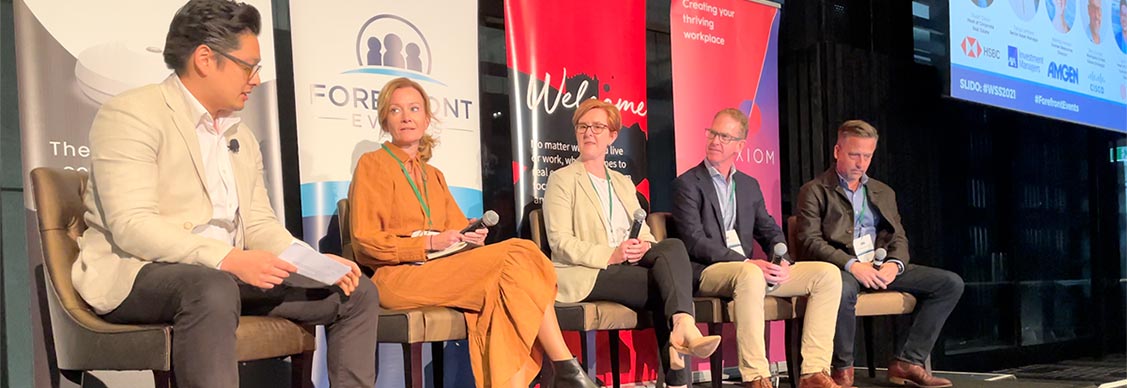What’s next for office design?
Hear what AXA Investment Managers, HSBC, and others are doing differently to keep workers happy
After a year of working from home, a key role of the office has become clear: it’s a place to socialise and innovate, not simply just write emails all day.
For office experts, this means understanding the specific needs and motivations of building users and delivering an experience that makes employees feel like the office is worth the commute.
“The inconvenient truth for the office market now is that things like high quality lighting and air conditioning are just entry level merits for today’s office,” says Tanya Lambert, senior asset manager at AXA Investment Managers’ alternatives investment business, AXA IM Alts. “Premium fixtures and fittings alone are not good enough, and most importantly we really need to understand who our customer is.”
Lambert was speaking about the future of the office at the Workplace Strategy Summit in Sydney, Australia, alongside Stuart Davie, head of corporate real estate in Australia for HSBC bank; Belinda Hansen, human resources director, Amgen; and CISCO Systems Inc. head of workplace strategy John Corbett.
Read on to hear more about their views on the changes and challenges ahead.
Employees are the customer
A more customer-focused approach to office design means that blanket fit-outs across office floors will no longer cut it for workers whose expectations of the office are increasing.
Smaller, bespoke spaces for specific teams or departments, which encourage and support interaction, will be the best way for businesses to entice workers into the office, says Stuart Davie, head of corporate real estate in Australia for HSBC bank.
“You don’t want to be coming into the office locking yourself away doing emails or back-to-back video conference calls. The office must be used as a vehicle for human interaction that also helps promote the culture you want to build for your organisation,” Davie says.
Managers aiming for happier and engaged workforces are looking at ways to proactively influence office design so workers don’t come to the office and “do nothing but write emails.”
“Lovely spaces that are all the same are no longer appropriate when collaboration is a major priority and what suits one team won’t always suit another,” he says.
Landlords change tack
To create customer-centric office buildings, landlords are recognising they need new strategies to get to know building occupiers. Presumptions can no longer be made based on the industry sectors of tenants, nor should decisions around design or building activations be made purely on the feedback of executives.
Meaningful investments can only be made by consulting a variety of stakeholders, including end users and future decision-makers, Lambert says.
Looking for more insights? Never miss an update.
The latest news, insights and opportunities from global commercial real estate markets straight to your inbox.
“There’s a lot of lip service given to knowing your customer,” she says. For example, she says AXA IM Alts has sought data-driven insights to learn the average age and demographic of its customers and what is important to them.
“None of this is that hard, but it’s certainly a great leap from where we were as owners in terms of what is needed to satisfy our customers, and for me that’s really interesting,” she says. “We’re moving up the risk curve as investors, and we can no longer simply buy an income stream and expect to keep delivering the same returns for our investors as we might have in the past.”
Increased collaboration
However, delivering highly successful offices is a conversation that starts long before office fit-outs. There must also be greater collaboration between developer, occupier and customer experience teams.
“All too often, especially amongst large institutional owners, development teams work very hard to deliver bricks and mortar in a vaguely convenient location and hope for the best, yet from a tech perspective and a customer experience perspective it’s not future-proofed,” Lambert says.
To mitigate irrelevant assets, AXA IM Alts has been mandating complete collaboration across multiple teams before tackling capital projects.
“It’s our responsibility to give our customers a better day in the office, so they know, when they’re making their commute, it’s worth it.”
Moving fast
Businesses are moving quickly to put workers first.
Biopharmaceutical company Amgen relinquished its office in the Sydney suburb of Ryde during COVID-19 lockdowns, leaving its 250 staff to work remotely.
However, extensive consultations with staff revealed that while individual productivity increased, along with wellbeing, it needed an office for its people to connect.
The company is taking the opportunity to move into the city centre, into a dedicated flexible working space.
“This will give us not only flexibility of space, but we’ll also be part of a larger community because what our people have told us is that they’re missing out on social connection,” says Belinda Hansen, human resources director, Amgen.
The case for listening
Employee feedback has also guided Salesforce’s new ‘work-from-anywhere’ model, which will see its employees globally work flexibly between home and in the office, apart from a small population whose roles require them to be in the office four to five days a week. Employees who don’t live near an office, or who have roles that don’t require an office will work remotely full time.
The company will be redesigning its offices to accommodate more hybrid workstyles.
“Gone are the days of a sea of desks — we’ll create more collaboration and breakout spaces to foster the human connection that can’t be replicated remotely,” says Salesforce president and chief people officer, Brent Hyder.
